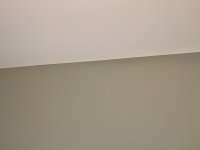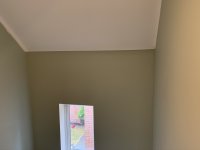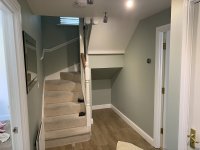Soldato
- Joined
- 30 Sep 2005
- Posts
- 16,553
I'm painting the entire house during lockdown and always wondered how I was going to cut the ceiling in above the second landing. The distance between the highest step and the ceiling is 4m and there's no safe way to get up a ladder to paint properly. Whilst I have gone up the ladder, it's not really very safe, and there's no way I can paint with any accuracy, although I can just about manage to sand/stick some masking tape on.
I've always usually gone freehand as even using the best masking tape can bleed at times, although I actually need to draw a straight line from one wall to another as the ceiling curves down in front of the landing banister. There's no way in hell I can get that done without tape and a roller on a long pole.
anyways, I stumbled across a youtube comment which said a trick he used was to put masking tape on, then paint over it with the same colour as what's underneath (in my case, white for the ceiling), then once it's dried to paint over it a second time with your actual wall colour (green). The first coat seals the edge of the tape, any bleed is invisible as it's the same colour as before.
Tried it yesterday and just took the masking tape off now. Wow!
This may be old news to most, but it's new to me






I've always usually gone freehand as even using the best masking tape can bleed at times, although I actually need to draw a straight line from one wall to another as the ceiling curves down in front of the landing banister. There's no way in hell I can get that done without tape and a roller on a long pole.
anyways, I stumbled across a youtube comment which said a trick he used was to put masking tape on, then paint over it with the same colour as what's underneath (in my case, white for the ceiling), then once it's dried to paint over it a second time with your actual wall colour (green). The first coat seals the edge of the tape, any bleed is invisible as it's the same colour as before.
Tried it yesterday and just took the masking tape off now. Wow!
This may be old news to most, but it's new to me









 I got the missus to do all the cutting in
I got the missus to do all the cutting in 
 It's so much better I'm going to redo it all.
It's so much better I'm going to redo it all.


